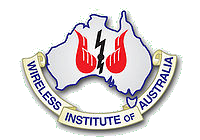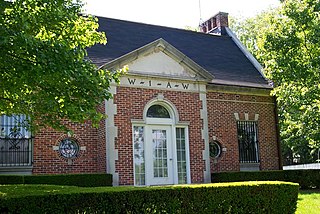
The Q-code is a standardised collection of three-letter codes that each start with the letter "Q". It is an operating signal initially developed for commercial radiotelegraph communication and later adopted by other radio services, especially amateur radio. To distinguish the use of a Q-code transmitted as a question from the same Q-code transmitted as a statement, operators either prefixed it with the military network question marker "INT" or suffixed it with the standard Morse question mark UD.

The Wireless Institute of Australia (WIA) was formed in 1910, and is the first and oldest national amateur radio society in the world. It represents the amateur radio operators of Australia as the AR "peak body" in dealings with the Australian Communications and Media Authority (ACMA), the authority under the government of Australia that administers communications within and external to Australia. The WIA publishes a bi-monthly journal for its membership called Amateur Radio. The organisation is the national society representing Australia in the International Amateur Radio Union. The WIA holds regular meetings with the ACMA to inform the Authority on matters concerning the Australian amateur radio community.

Radio Amateurs of Canada (RAC), known in French as Radio Amateurs du Canada, is the national association for Amateur Radio in Canada. It is a not-for-profit membership association with headquarters in Ottawa, Ontario, Canada, representing the interests of Amateur Radio all across Canada. Speaking on behalf of Canadian Radio Amateurs, RAC provides liaison with government agencies and carries the Amateur voice about regulatory and spectrum issues to the discussion table with government and industry leaders, nationally and internationally.
In broadcasting and radio communications, a call sign is a unique identifier for a transmitter station. A call sign can be formally assigned by a government agency, informally adopted by individuals or organizations, or even cryptographically encoded to disguise a station's identity.

In times of crisis and natural disasters, amateur radio is often used as a means of emergency communication when wireline, cell phones and other conventional means of communications fail.
Ham radio is a popular term for amateur radio, derived from "ham" as an informal name for an amateur radio operator. The use first appeared in the United States during the opening decade of the 20th century—for example, in 1909, Robert A. Morton reported overhearing an amateur radio transmission which included the comment: "Say, do you know the fellow who is putting up a new station out your way? I think he is a ham." However, the term did not gain widespread usage in the United States until around 1920, after which it slowly spread to other English-speaking countries.

W1AW is both the amateur radio call sign and the primary operating station of the American Radio Relay League (ARRL). This station, which is commonly called the Hiram Percy Maxim Memorial Station, is located on the grounds of ARRL Headquarters in Newington, Connecticut. It was inspired by Maxim's 1AW callsign which predated the use of the AA-AL, K, N and W prefixes. The station routinely transmits bulletins and Morse code practice using common amateur radio frequencies. During a communications emergency bulletins are transmitted hourly in order to keep amateur radio operators informed.

The Trinidad and Tobago Amateur Radio Society, Inc. (TTARS) is the national amateur radio organization in the Republic of Trinidad and Tobago. It is a member society of the International Amateur Radio Union (IARU).

A QSL card is a written confirmation of either a two-way radiocommunication between two amateur radio or citizens band stations; a one-way reception of a signal from an AM radio, FM radio, television or shortwave broadcasting station; or the reception of a two-way radiocommunication by a third party listener. A typical QSL card is the same size and made from the same material as a typical postcard, and most are sent through the mail as such.

Amateur Radio Emergency Communications (AREC), formerly the Amateur Radio Emergency Corps, is a service provided by the New Zealand Association of Radio Transmitters (NZART) which provides trained radio communicators and communication systems for emergency situations.
The history of amateur radio, dates from the dawn of radio communications, with published instructions for building simple wireless sets appearing at the beginning of the twentieth century. Throughout its history, amateur radio enthusiasts have made significant contributions to science, engineering, industry, and social services. Research by amateur radio operators has founded new industries, built economies, empowered nations, and saved lives in times of emergency.
Call signs in New Zealand are no longer generally used to identify broadcast stations. However, New Zealand's radio stations were once known by their call signs and would usually broadcast their call signs as a number followed by X, Y, or Z, and another letter. Call signs are regulated internationally by the ITU and nationally by the Ministry of Business, Innovation and Employment (MBIE), formerly the Ministry of Economic Development. The ministry is also responsible for providing policy advice to Government on the allocation of New Zealand's radio spectrum to support, efficient, reliable and responsive wireless telecommunications and broadcasting infrastructure.
Call signs in India are unique identifiers for telecommunications and broadcasting in India. The Ministry of Communications and Information Technology regulates call signs nationally, and the International Telecommunication Union regulates call signs internationally.
Amateur radio or ham radio is practised by more than 22,000 licensed users in India. The first amateur radio operator was licensed in 1921, and by the mid-1930s, there were around 20 amateur radio operators in India. Amateur radio operators played an important part in the Indian independence movement with the establishment of illegal pro-independence radio stations in the 1940s. The three decades after India's independence saw only slow growth in the number of operators until the then Prime Minister of India and amateur radio operator, Rajiv Gandhi (VU2RG), waived the import duty on wireless equipment in 1984. Since then, numbers have picked up, and as of 2007, there were more than 16,000 operators in the country. Amateur radio operators have played a vital role during disasters and national emergencies such as earthquakes, tsunamis, cyclones, floods, and bomb blasts, by providing voluntary emergency communications in the affected areas.
Call signs in Australia are allocated by the Australian Communications and Media Authority and are unique for each broadcast station. The use of callsigns on-air in both radio and television in Australia is optional, so many stations used other on-air identifications. Australian broadcast stations officially have the prefix VL- and originally all callsigns used that format, but since Australia has no nearby neighbours, this prefix is no longer used except in an international context.
The Irish Radio Transmitters Society (IRTS) is a national non-profit organization for amateur radio enthusiasts in Ireland. Key missions of the IRTS include promoting amateur radio experimentation and representing the interests of Irish amateur radio operators before Irish and international telecommunications regulatory authorities. In particular, since 2005 in agreement with Communications Regulator (Comreg), the IRTS supports the entire examination process for the Experimenter's Licence including setting, organising, and correcting examinations for the Irish amateur radio license. The organization has no paid employees, and all tasks are performed by volunteers. IRTS is the national member society representing Ireland in the International Amateur Radio Union.
The Lietuvos Radijo Mėgėjų Draugija (LRMD) is a national non-profit organization for amateur radio enthusiasts in Lithuania. LRMD represents the interests of Lithuanian amateur radio operators before Lithuanian, European, and international telecommunications regulatory authorities. LRMD is the national member society representing Lithuania in the International Amateur Radio Union.
Amateur radio call signs are allocated to amateur radio operators around the world. The call signs are used to legally identify the station or operator, with some countries requiring the station call sign to always be used and others allowing the operator call sign instead.
Call signs in Mexico are unique identifiers for telecommunications, radio communication, radio broadcasting and transmission. They are regulated internationally by the International Telecommunication Union (ITU) as well as nationally by the Federal Telecommunications Institute, which regulates broadcast stations, wireless telecommunications and spectrum use.
Broadcast call signs are call signs assigned as unique identifiers to radio stations and television stations. While broadcast radio stations will often brand themselves with plain-text names, identities such as "cool FM", "rock 105" or "the ABC network" are not globally unique. Another station in another city or country may have a similar brand, and the name of a broadcast station for legal purposes is normally its internationally recognised ITU call sign. Some common conventions are followed around the world.








